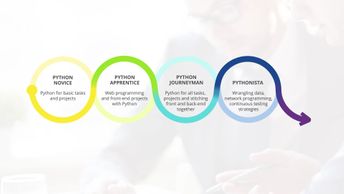Final Exam: Python Novice - access and update list elements
- add, remove, sort, and reverse elements from a list
- code for loops to iterate over values in a tuple and the keys and values in a dictionary
- convey the fact that no action is performed under specific conditions by using the pass statement
- create and initialize dictionaries
- create and initialize lists in Python
- create and initialize sets
- create closures that have access to local state variables
- create deep copies of lists where changes to the copy do not affect the original
- create dictionaries with other complex data types as values
- create floating point, integer, Boolean, and string variables
- create new lists from existing lists using slicing operations
- create shallow copies of lists
- define and invoke functions with input arguments
- define closures in Python
- define functions
- define, invoke, and name functions
- evaluate conditions involving complex data types using if statements
- evaluate conditions involving primitive data types using if statements
- evaluate multiple conditions for decision making
- executing built-in functions with lists
- identify how conditions in Python work
- identify when it is appropriate to use the break keyword to stop a while loop
- implement a basic while loop and recognize what conditions can cause it to become an infinite loop
- implement basic concepts into some real programming such as conversions between datatypes and some Python built-in methods
- implement custom functions
- implement function recursion
- implement generator functions using the yield keyword
- include if-else statements and other for loops within a for loop
- install the Anaconda distribution of Python to run Python in a Windows environment
- invoke a function from within its body
- modify and update dictionaries using dictionary methods
- pass functions as input arguments
- pass functions as input arguments to other functions
- perform shallow and deep copies of Python strings
- perform shallow and deep copies of sets
- recall custom functions
- recall how functions work as objects
- recall how to convert an integer to a float, and a float or an integer to a string and vice-versa
- recall the syntax for defining while loops within a single line
- recall what it means to pass arguments by value
- recognize the function of associating an else block with a Python for loop
- reference global variables from within a function
- return information from functions
- run the Jupyter notebook server to execute Python code on a Mac machine
- run the Jupyter notebook server to execute Python code on a Windows machine
- skip an iteration of a for loop when a specific condition is met using the continue statement
- skip steps in individual iterations of a while loop using the continue statement
- solve various programming problems using some Python built-in methods
- specify global and local variables in Python
- specify the similarities between lists and tuples
- terminate a for loop when a specific condition is met using the break statement
- use built-in functions in Python to perform operations
- use for loops to process the elements in a list and the characters in a string
- use the else keyword
- use the Jupyter notebook server to execute Python code on a Mac machine
- use variables in place of values directly
- use while loops to carry out actions while evaluating expressions based on numerical and string data
- work with the math module in Python
- work with the os module in Python
|


